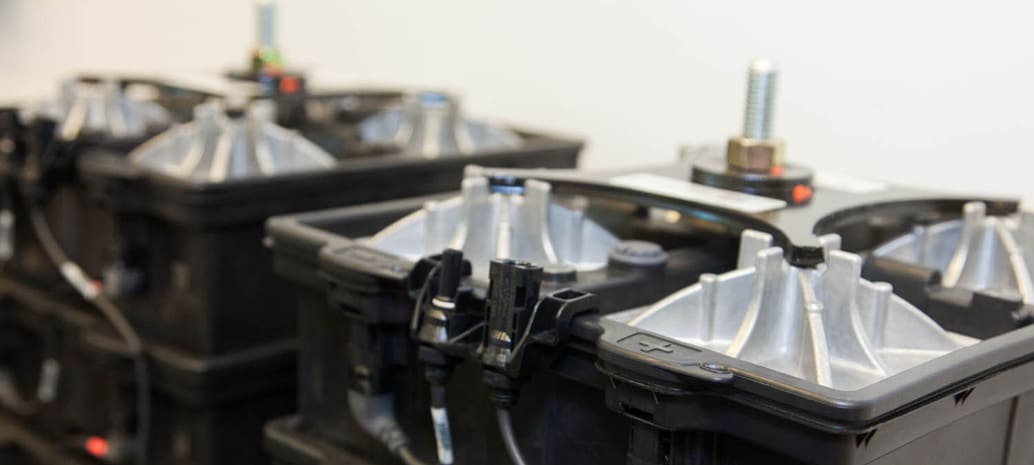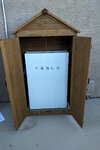Fun with Bollards and Fire codes!
That link is from a 4 year old article, so not super recent.
Caution the text below is pretty crunchy, and very current.
Today the CFC and CRC code says that the ESS must be 36" apart unless there has been large-scale UL 9540A fire testing. Tesla has passed this testing and the results speak for themselves. The batteries perform amazingly under forced thermal runaway.
The minimum fire code compliant separation today for Tesla Powerwall is 6" on the side and 1" face to face (stacked configuration). Some fire officials disagree and think these ESS are subject to thermal runaway at any moment, so are restricting them regardless. The truth is that most likely any event smaller than about half a dozen cells going up at once and adjacent top each other event will be contained in a puff of smoke and the built in safety features of the Powerwall will ensure that even an adjacent wood wall or soffit would not ignite.
To this day not one person has been hurt by a UL 9540A listed fire event. Granted the UL standard isn't super old either but hundreds of thousands of Powerwalls have been installed. I really do not know how many but our company alone is going on 3k units installed.
As far as bollards, there is good code basis for this now that has been adopted by the ICC and the CBSC. Next year California will adopt a piece of code I helped create, regarding exactly this issue of impact protection in residential garages.
2021 CFC 1207.11.7 will be adopted on Jan. 1, 2023.
Also, I have attached in PDF what Woodside Fire ruled as far as impact protection at the end of 2020. They are quite a wooded area in a CALFIRE Very High fire danger area.
Here's the picture part of the new code 1207.11.7.1
View attachment 784258
Here is the approximate code language subject to final approvals and editorial boards:
1207.11.7 Protection from impact. ESS installed in a location subject to vehicle damage in accordance with Section 1207.11.7.1 or 1207.11.7.2 shall be provided with impact protection in accordance with Section 1207.11.7.3.
1207.11.7.1 Garages.
Where an ESS is installed in the normal driving path of vehicle travel within a garage, impact protection complying with Section 1207.11.3 shall be
installed. The normal driving path is a line perpendicular to the garage vehicle opening to the back wall, extending 3 ft. (914 mm) to either side along
the back wall and to a height of 48 in. (1219 mm), (See Figure 1207.11.7.1)
Exception: Where the clear height of the vehicle garage opening is 7 ft 6 in, (2286 mm) or less, ESS installed not less than 36 inches (914 mm)
above finished floor are not subject to vehicle impact protection requirements.
1207.11.7.2 Other locations subject to vehicle impact.
Where an ESS is installed in a location other than as defined in Section 1207.11.7.1, and is subject to vehicle damage, impact protection shall be
provided in accordance with Section 1207.11.7.3.
1207.11.7.3 Impact Protection Options.
Where ESS is required to be protected from impact in accordance with Section 1207.11.7.1 or 1207.11.7.2 such protection shall comply with one of
the following:
1. Bollards constructed in accordance with one of the following:
1.1 48 inches (1219 mm) in length by 3 inches (76mm) in diameter schedule. 80 steel pipe embedded in a concrete pier 12 inches (304
mm) deep and 6 inches (152 mm) in diameter, with 36 inches (914 mm) of pipe exposed, filled with concrete, and spaced at a maximum
interval of 5 feet (1524 mm). Each bollard shall be located not less than 6 inches (152 mm) from an ESS.
1.2 36 inches (914 mm) in height by 3 inches (76 mm) in diameter schedule 80 steel pipe fully welded to an 8 inches (203 mm) by 8 inches
(203 mm) by ¼ inch (6.4 mm) thick steel plate and bolted to a concrete floor by means of 4 - ½ inch (13 mm) concrete anchors with 3
inch (76 mm) minimum embedment. Spacing shall be not greater than 60 inches. (1524 mm), and each bollard shall be located not less
than 6 inches (152 mm) from the ESS.
1.3 Pre-manufactured steel pipe bollards shall be filled with concrete and anchored in accordance with the manufacturer's installation
instructions, with spacing not greater than a 60 inches. (1524 mm). Located not less than 6 inches (152mm) from the ESS.
2. Wheel barriers constructed in accordance with one of the following:
2.1. 6 inches (152 mm ) in height by 6 inches (152 mm) in width wheel barrier made of concrete or polymer, anchored to the concrete floor
not less than every 36 inches (914 mm) and located not less than 54 inches (1372 mm) from the ESS.. Minimum 2 - ½ inch (13 mm)
diameter concrete anchors with 3 inch (76 mm) embedment per barrier shall be used. Spacing between barriers shall be no greater
than 36 inches. (914 mm).
2.2. Pre-manufactured wheel barriers shall be anchored in accordance with the manufacturers installation instructions.
3. Approved method designed to resist a 2000 lbf (8899 Newtons) impact in the direction of travel at 24 inches (608 mm) above grade.
TLDR Don't Drive Into Your Batteries





